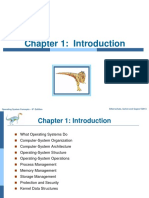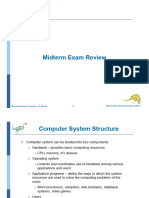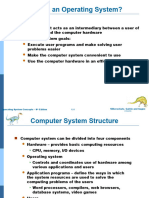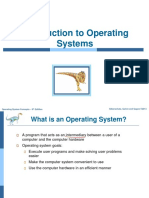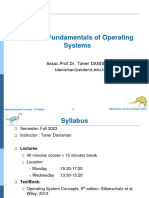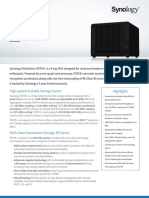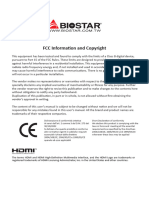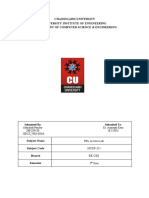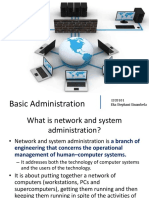Lecture 2
Chapter 1: Introduction (Cont.)
Operating System Concepts – 9th Edit9on Silberschatz, Galvin and Gagne ©2013
� Computer-System Architecture
Most systems use a single general-purpose processor
Most systems have special-purpose processors as well (device-
specific processor)
Special-purpose processors run a limited instruction set and don’t run
user process
Operating System Concepts – 9th Edition 1.4 Silberschatz, Galvin and Gagne ©2013
� Computer-System Architecture
Multiprocessors systems growing in use and importance
Also known as parallel systems, tightly-coupled systems
Advantages include:
1. Increased throughput: more work done in less time
2. Economy of scale: cost less than multiple single-processor systems
because they share peripherals, storage, power supply.
3. Increased reliability : failure of one processor will not halt the system,
only slow it down.
Two types:
1. Asymmetric Multiprocessing – each processor is assigned a specific
task. A master processor controls the system (Master-Slave relation
ship)
2. Symmetric Multiprocessing – each processor performs all tasks
within the OS
(no Master-Slave relation ship) all processors are peers.
Operating System Concepts – 9th Edition 1.5 Silberschatz, Galvin and Gagne ©2013
� Symmetric Multiprocessing Architecture
Difference between symmetric and asymmetric multiprocessing may result
from either SW or HW
Special HW can differentiate the multiple processors
SW can be written to allow only one master and multiple slaves
Operating System Concepts – 9th Edition 1.6 Silberschatz, Galvin and Gagne ©2013
� A Dual-Core Design
Multi-chip and multicore
Systems containing all chips
Chassis containing multiple separate systems
Operating System Concepts – 9th Edition 1.7 Silberschatz, Galvin and Gagne ©2013
� Clustered Systems
Like multiprocessor systems, but multiple systems working together
Usually sharing storage via a storage-area network (SAN)
Provides a high-availability service which survives failures
Asymmetric clustering has one machine in hot-standby mode
Symmetric clustering has multiple nodes running applications,
monitoring each other
Some clusters are for high-performance computing (HPC)
Applications must be written to use parallelization
Operating System Concepts – 9th Edition 1.8 Silberschatz, Galvin and Gagne ©2013
� Clustered Systems
Operating System Concepts – 9th Edition 1.9 Silberschatz, Galvin and Gagne ©2013
� Operating System Structure
Multiprogramming (Batch system) needed for efficiency
Single user cannot keep CPU and I/O devices busy at all times
Multiprogramming organizes jobs (code and data) so CPU always has one
to execute
A subset of total jobs in system is kept in memory
One job selected and run via job scheduling
When it has to wait (for I/O for example), OS switches to another job
Timesharing (multitasking) is logical extension in which CPU switches jobs
so frequently that users can interact with each job while it is running, creating
interactive computing
Response time should be < 1 second
Each user has at least one program executing in memory process
If several jobs ready to run at the same time CPU scheduling
If processes don’t fit in memory, swapping moves them in and out to run
Virtual memory allows execution of processes not completely in memory
Operating System Concepts – 9th Edition 1.10 Silberschatz, Galvin and Gagne ©2013
� Memory Layout for Multiprogrammed System
Operating System Concepts – 9th Edition 1.11 Silberschatz, Galvin and Gagne ©2013
� Operating-System Operations
Interrupt driven (hardware and software)
Hardware interrupt by one of the devices
Software interrupt (exception or trap):
Software error (e.g., division by zero)
Request for operating system service
Other process problems include infinite loop, processes
modifying each other or the operating system
Operating System Concepts – 9th Edition 1.12 Silberschatz, Galvin and Gagne ©2013
� Operating-System Operations (cont.)
Dual-mode operation allows OS to protect itself and other system
components
User mode and kernel mode (Supervisor mode, System
mode)
Mode bit provided by hardware
Provides ability to distinguish when system is running user
code or kernel code
Some instructions designated as privileged, only
executable in kernel mode
System call changes mode to kernel, return from call resets
it to user
Operating System Concepts – 9th Edition 1.13 Silberschatz, Galvin and Gagne ©2013
� Transition from User to Kernel Mode
Operating System Concepts – 9th Edition 1.14 Silberschatz, Galvin and Gagne ©2013
� Process Management
A process is a program in execution. It is a unit of work within the
system. Program is a passive entity, process is an active entity.
Process needs resources to accomplish its task
CPU, memory, I/O, files
Initialization data
Process termination requires reclaim of any reusable resources
Single-threaded process has one program counter specifying
location of next instruction to execute
Process executes instructions sequentially, one at a time, until
completion
Multi-threaded process has one program counter per thread
Typically system has many processes, some user, some operating
system running concurrently on one or more CPUs
Concurrency by multiplexing the CPUs among the processes /
threads
Operating System Concepts – 9th Edition 1.15 Silberschatz, Galvin and Gagne ©2013
� Process Management Activities
The operating system is responsible for the following activities in
connection with process management:
Creating and deleting both user and system processes
Suspending and resuming processes
Providing mechanisms for process synchronization
Providing mechanisms for process communication
Operating System Concepts – 9th Edition 1.16 Silberschatz, Galvin and Gagne ©2013
� Memory Management
To execute a program all (or part) of the instructions must be in
memory
All (or part) of the data that is needed by the program must be in
memory.
Memory management determines what is in memory and when
Optimizing CPU utilization and computer response to users
Memory management activities
Keeping track of which parts of memory are currently being
used and by whom
Deciding which processes (or parts thereof) and data to
move into and out of memory
Allocating and deallocating memory space as needed
Operating System Concepts – 9th Edition 1.17 Silberschatz, Galvin and Gagne ©2013
� Storage Management
OS provides uniform, logical view of information storage
Abstracts physical properties to logical storage unit - file
Each medium is controlled by device (i.e., disk drive, tape drive)
Varying properties include access speed, capacity, data-
transfer rate, access method (sequential or random)
File-System management
Files usually organized into directories
Access control on most systems to determine who can access
what
OS activities include
Creating and deleting files and directories
Primitives to manipulate files and directories
Mapping files onto secondary storage
Backup files onto stable (non-volatile) storage media
Operating System Concepts – 9th Edition 1.18 Silberschatz, Galvin and Gagne ©2013
� Mass-Storage Management
Usually disks used to store data that does not fit in main memory or
data that must be kept for a “long” period of time
Proper management is of central importance
OS activities
Free-space management
Storage allocation
Disk scheduling
Operating System Concepts – 9th Edition 1.19 Silberschatz, Galvin and Gagne ©2013
� Migration of data “A” from Disk to Register
Multitasking environments must be careful to use most recent
value, no matter where it is stored in the storage hierarchy
Multiprocessor environment must provide cache coherency in
hardware such that all CPUs have the most recent value in their
cache
Distributed environment situation even more complex
Several copies of a datum can exist
Various solutions covered in Chapter 17
Operating System Concepts – 9th Edition 1.20 Silberschatz, Galvin and Gagne ©2013
� I/O Subsystem
One purpose of OS is to hide peculiarities of hardware devices
from the user
I/O subsystem responsible for
Memory management of I/O including buffering (storing data
temporarily while it is being transferred), caching (storing parts
of data in faster storage for performance), spooling (the
overlapping of output of one job with input of other jobs)
General device-driver interface
Drivers for specific hardware devices
Operating System Concepts – 9th Edition 1.21 Silberschatz, Galvin and Gagne ©2013
� Protection and Security
Protection – any mechanism for controlling access of processes or
users to resources defined by the OS
A protection-oriented system provides a means to distinguish
between authorized and unauthorized usage
Security – defense of the system against internal and external attacks
Huge range, including denial-of-service, worms, viruses, identity
theft, theft of service
Systems generally first distinguish among users, to determine who
can do what
User identities (user IDs, security IDs) include name and
associated number, one per user
User ID then associated with all files, processes of that user to
determine access control
Group identifier (group ID) allows set of users to be defined and
controls managed, then also associated with each process, file
Operating System Concepts – 9th Edition 1.22 Silberschatz, Galvin and Gagne ©2013
� Computing Environments - Traditional
Stand-alone general purpose machines
But blurred as most systems interconnect with others (i.e.,
the Internet)
Portals provide web access to internal systems
Network computers (thin clients) are like Web terminals
Mobile computers interconnect via wireless networks
Networking becoming ubiquitous – even home systems use
firewalls to protect home computers from Internet attacks
Operating System Concepts – 9th Edition 1.23 Silberschatz, Galvin and Gagne ©2013
� Computing Environments - Mobile
Handheld smartphones, tablets, etc
What is the functional difference between them and a
“traditional” laptop?
Amount of physical memory
Speed of the processor
Lack of physical space
Extra feature – more OS features (GPS)
Allows new types of apps
Use IEEE 802.11 wireless, or cellular data networks for
connectivity
Leaders are Apple iOS and Google Android
Operating System Concepts – 9th Edition 1.24 Silberschatz, Galvin and Gagne ©2013
� Computing Environments – Distributed
Distributed computing
Collection of separate, possibly heterogeneous, systems
networked together
Network is a communications path, TCP/IP most common
– Local Area Network (LAN)
– Wide Area Network (WAN)
– Metropolitan Area Network (MAN)
Network Operating System provides features like file sharing
between systems across network
Includes communication scheme allows systems to
exchange messages
Different OSs communicate closely to provide the Illusion
of that a single system controls the network
Operating System Concepts – 9th Edition 1.25 Silberschatz, Galvin and Gagne ©2013
� Computing Environments – Client-Server
Client-Server Computing
Many systems now servers, responding to requests generated
by clients
Compute-server system provides an interface to client to
request services (i.e., database)
File-server system provides interface for clients to store
and retrieve files
Operating System Concepts – 9th Edition 1.26 Silberschatz, Galvin and Gagne ©2013
� Computing Environments - Peer-to-Peer
Another model of distributed system
P2P does not distinguish clients and servers
Instead all nodes are considered peers
May each act as client, server or both
Node must join P2P network
Registers its service with central
lookup service on network, or
Examples include Napster and Gnutella,
Voice over IP (VoIP) such as Skype
Operating System Concepts – 9th Edition 1.27 Silberschatz, Galvin and Gagne ©2013
� Computing Environments - Virtualization
Allows operating systems to run applications within other OSes
Vast and growing industry
Virtualization – OS natively compiled for CPU, running guest
OSes also natively compiled
VMM (virtual machine Manager) provides virtualization
services
Use cases involve laptops and desktops running multiple OSes
for exploration or compatibility
Apple laptop running Mac OS X host, Windows as a guest
Operating System Concepts – 9th Edition 1.28 Silberschatz, Galvin and Gagne ©2013
� Computing Environments - Virtualization
Operating System Concepts – 9th Edition 1.29 Silberschatz, Galvin and Gagne ©2013
� Computing Environments – Cloud Computing
Delivers computing, storage, even apps as a service across a network
Logical extension of virtualization because it uses virtualization as the base
for its functionality.
Amazon EC2 has thousands of servers, millions of virtual machines,
petabytes of storage available across the Internet, pay based on usage
Many types
Public cloud – available via Internet to anyone willing to pay
Private cloud – run by a company for the company’s own use
Hybrid cloud – includes both public and private cloud components
Software as a Service (SaaS) – one or more applications available via
the Internet (i.e., word processor)
Platform as a Service (PaaS) – software stack ready for application use
via the Internet (i.e., a database server)
Infrastructure as a Service (IaaS) – servers or storage available over
Internet (i.e., storage available for backup use)
Operating System Concepts – 9th Edition 1.30 Silberschatz, Galvin and Gagne ©2013
� Computing Environments – Cloud Computing
Cloud computing environments composed of traditional OSes,
plus VMMs, plus cloud management tools
Internet connectivity requires security like firewalls
Load balancers spread traffic across multiple applications
Operating System Concepts – 9th Edition 1.31 Silberschatz, Galvin and Gagne ©2013
� Computing Environments – Real-Time Embedded Systems
Real-time embedded systems most prevalent form of computers
Vary considerable, special purpose, limited purpose OS,
real-time OS
Many other special computing environments as well
Some have OSes, some perform tasks without an OS
Real-time OS has well-defined fixed time constraints
Processing must be done within constraint
Correct operation only if constraints met
Operating System Concepts – 9th Edition 1.32 Silberschatz, Galvin and Gagne ©2013
� End of Chapter 1
Operating System Concepts – 9th Edit9on Silberschatz, Galvin and Gagne ©2013







